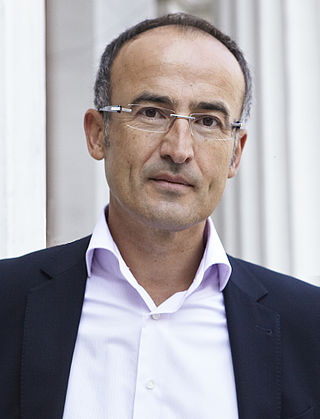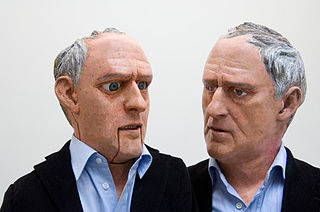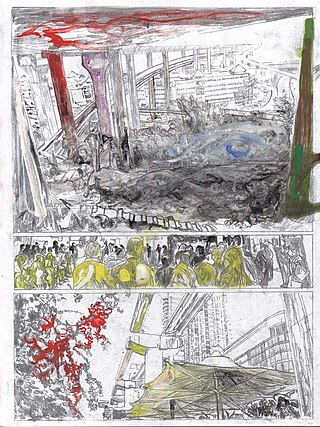
Igor Sacharow-Ross (born 1947) is a German-Russian visual artist who works in Cologne and Munich.

Igor Sacharow-Ross (born 1947) is a German-Russian visual artist who works in Cologne and Munich.
Igor Sacharow-Ross was born in Khabarovsk in the Russian Far East. As a nonconformist artist in the Soviet Union of the 1970s, he was subject to political persecution, and eventually deported in 1978. [1]
Hubertus von Amelunxen is a philosopher, art historian, editor, curator, photography critic, and professor for philosophy of photography and cultural studies. Amelunxen has authored and published several books focusing on the history and theory of photography and has curated several international exhibitions. He served as president and provost at the European Graduate School, based in Saas-Fee, Switzerland, and Valletta, Malta from October 2013 until June 2018.
Michael Buthe was a German artist who lived and worked between Germany and Morocco. He exhibited widely throughout Europe during his life and is known for his eclectic and prolific oeuvre which encompasses painting, sculpture, and installation.

Jürgen Partenheimer is a German artist. His works span a range of media, from painting, drawing, sculpture, printmaking, artists books, texts and installations. He lives and works in Germany and Italy.
Andro Wekua is a Georgian artist based in Zurich, Switzerland, and Berlin, Germany.

Stefan Szczesny is a German painter, draughtsman, and sculptor. He is best known for co-founding the Neue Wilde movement in the early 1980s.

Robin Page was a British painter. He was one of the early members of the Fluxus art movement.

Boris Efimovich Groys is an art critic, media theorist, and philosopher. He is currently a global distinguished professor of Russian and Slavic studies at New York University and senior research fellow at the Karlsruhe University of Arts and Design in Karlsruhe, Germany. He has been a professor of aesthetics, art history, and media theory at the Karlsruhe University of Arts and Design/Center for Art and Media in Karlsruhe and an internationally acclaimed professor at a number of universities in the United States and Europe, including the University of Pennsylvania, the University of Southern California and the Courtauld Institute of Art London.

Tobias G. Natter is an Austrian art historian and internationally renowned art expert with a particular expertise in "Vienna 1900".
Franz Rosei is an Austrian sculptor and draughtsman. His brother is the writer Peter Rosei.

Stephan Huber is a German sculptor and object artist.

Stefan Ettlinger is a German painter and draughtsman. He studied at the Kunstakademie Düsseldorf at Alfonso Hüppi as a master student. He lives and works in Düsseldorf.
e-flux publications includes both the e-flux journal and e-flux journal reader series. The monthly art publication e-flux journal features essays and contributions by contemporary artists and thinkers. The e-flux journal reader series was initiated in 2009 as a joint imprint with Sternberg Press.
Mark Harrington is an American-born Europe-based painter who has exhibited widely in Europe and the United States since the early 1990s.
Peter Zimmermann is a German painter, sculptor, object artist and university professor.

Sylke von Gaza is a German artist. First and foremost an abstract painter, she also pursues numerous projects that investigate the effect and impact of painting in architectural spaces and the process of painting including site-specific settings. Von Gaza lives and works in Munich, Venice and Zurich.

Günther Selichar is an Austrian visual artist.

Haralampi G. Oroschakoff is an Austrian painter, writer and publisher. He is considered a pioneer of the East-West dialogue in art and a reviver of the reception of Eastern iconography in Western painting. Oroschakoff participated in TEDxLambeth 2019 as a speaker regarding the subject matter of conceptualism.

Wolf Röhricht was a German painter. His work was part of the painting event in the art competition at the 1928 Summer Olympics.

Franz Joseph Esser was a German painter, watercolorist, caricaturist, draftsman and graphic artist who was both close to the Cologne Progressives and a member of the Nazi party.

Milan Kunc is a Czech postmodern painter and sculptor. He is known for "Embarrassing Realism," "Pop Surrealism," and "Ost-Pop," art movements characterized by their critique of society and media through ironic or melodramatic subject matter. In the late 1970s and early 1980s, his work, which often contrasted with the era's mainstream, made him a member of the Neue Wilde.